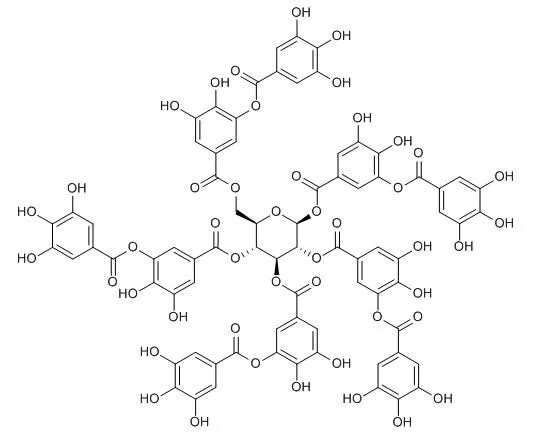| In vitro: |
| Parasite Immunol. 2014 Feb;36(2):100-6. | | Effects of tannic acid on Haemonchus contortus larvae viability and immune responses of sheep white blood cells in vitro.[Pubmed: 24558656] |
METHODS AND RESULTS:
Direct inhibitory effects of Tannic acid on Haemonchus contortus viability were studied in vitro using the larval migration inhibition (LMI) assay. Sheep white blood cells (WBC) were preincubated with 5 and 50 lg/mL Tannic acid or not followed by whole H. contortus antigen (WHA). Cells were harvested at 24 h post-incubation to test host immune responses. Concentrations of 50, 100, 500, 1000, 3000 and 5000 lg/mL Tannic acid inhibited larvae migration by 19.8, 42.4, 46.3, 92.0, 93.7 and 100%, respectively, within 96 h post-incubation (P < 0.001). The relative mRNA levels of interferon (IFN)-c, interleukin (IL)-2, IL-4 and IL-10 were increased by WHA stimulation without Tannic acid. However, the increased effects on IFN-c and IL-2 were inhibited by Tannic acid preincubation (P < 0.001), while the increases in IL-4 and IL-10 were greatly enhanced by Tannic acid preincubation (P < 0.001). Changes in protein levels of all cytokines essentially paralleled the changes in their corresponding mRNA levels.
CONCLUSIONS:
In conclusion, Tannic acid is directly harmful to larvae in a dose- and time-dependent manner and modulates immune responses of sheep WBC stimulated by H. contortus antigen by inhibiting Th1 cytokines and increasing Th2 cytokine expression in vitro. | | Biol Trace Elem Res. 2014 Apr;158(1):122-7. | | Effect of calcium, tannic acid, phytic acid and pectin over iron uptake in an in vitro Caco-2 cell model.[Pubmed: 24531910] | Calcium, phytic acid, polyphenols and fiber are major inhibitors of iron absorption and they could be found in excess in some diets, thereby altering or modifying the iron nutrition status. The purpose of this study is to evaluate the effect of calcium, Tannic acid, phytic acid, and pectin over iron uptake, using an in vitro model of epithelial cells (Caco-2 cell line).
METHODS AND RESULTS:
Caco-2 cells were incubated with iron (10-30 μM) with or without CaCl2 (500 and 1,000 μM) for 24 h. Then, cells were challenged with phytic acid (50-150 μM); pectin (50-150 nM) or Tannic acid (100-500 μM) for another 24 h. Finally, (55)Fe (10 μM) uptake was determined. Iron dialyzability was studied using an in vitro digestion method. Iron uptake in cells pre-incubated with 20 and 30 μM Fe was inhibited by CaCl2 (500 μM). Iron uptake decreased in cells cultured with Tannic acid (300 μM) and CaCl2 (500-1,000 μM) (two-way ANOVA, p = 0.002). Phytic acid also decreased iron uptake mainly when cells were treated with CaCl2 (1,000 μM) (two-way ANOVA; p < 0.05). Pectin slightly decreased iron uptake (p = NS). Iron dialyzability decreased when iron was mixed with CaCl2 and phytic or Tannic acid (T test p < 0.0001, for both) but not when mixed with pectin.
CONCLUSIONS:
Phytic acid combined with calcium is a strong iron uptake inhibitor. Pectin slightly decreased iron uptake with or without calcium. Tannic acid showed an unexpected behavior, inducing an increase on iron uptake, despite its low Fe dialyzability. | | PLoS One. 2014 Aug 12;9(8):e104113. | | Tannic acid modified silver nanoparticles show antiviral activity in herpes simplex virus type 2 infection.[Pubmed: 25117537] | The interaction between silver nanoparticles and herpesviruses is attracting great interest due to their antiviral activity and possibility to use as microbicides for oral and anogenital herpes.
METHODS AND RESULTS:
In this work, we demonstrate that Tannic acid modified silver nanoparticles sized 13 nm, 33 nm and 46 nm are capable of reducing HSV-2 infectivity both in vitro and in vivo. The antiviral activity of Tannic acid modified silver nanoparticles was size-related, required direct interaction and blocked virus attachment, penetration and further spread. All tested Tannic acid modified silver nanoparticles reduced both infection and inflammatory reaction in the mouse model of HSV-2 infection when used at infection or for a post-infection treatment. Smaller-sized nanoparticles induced production of cytokines and chemokines important for anti-viral response. The corresponding control buffers with Tannic acid showed inferior antiviral effects in vitro and were ineffective in blocking in vivo infection.
CONCLUSIONS:
Our results show that Tannic acid modified silver nanoparticles are good candidates for microbicides used in treatment of herpesvirus infections. |
|






 Cell. 2018 Jan 11;172(1-2):249-261.e12. doi: 10.1016/j.cell.2017.12.019.IF=36.216(2019)
Cell. 2018 Jan 11;172(1-2):249-261.e12. doi: 10.1016/j.cell.2017.12.019.IF=36.216(2019) Cell Metab. 2020 Mar 3;31(3):534-548.e5. doi: 10.1016/j.cmet.2020.01.002.IF=22.415(2019)
Cell Metab. 2020 Mar 3;31(3):534-548.e5. doi: 10.1016/j.cmet.2020.01.002.IF=22.415(2019) Mol Cell. 2017 Nov 16;68(4):673-685.e6. doi: 10.1016/j.molcel.2017.10.022.IF=14.548(2019)
Mol Cell. 2017 Nov 16;68(4):673-685.e6. doi: 10.1016/j.molcel.2017.10.022.IF=14.548(2019)